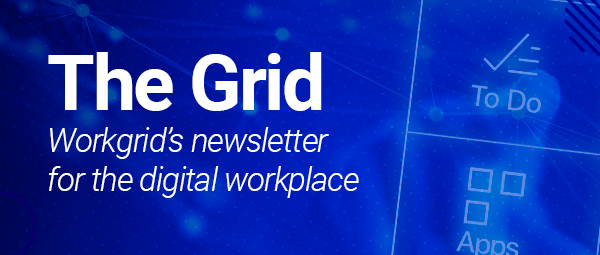Technology isn’t the most important factor in the digital workplace
From collaboration and productivity tools to communication platforms and increased mobile access to enterprise solutions, technology has played a starring role in laying down a foundation to support long-term business and employee success.
But that doesn’t mean the hard work is done – or that technology should even be the primary focus of the digital workplace.
![[asset] hands-free-driving-stock-photo](https://images.ctfassets.net/z7p73u8c0thn/EzyoExCi2Z3tAEY9HVYMe/957812e75b3c8c7d0078c95e437f4ccf/hands-free-driving-stock-photo.png?w=1200&h=675&q=60&fm=png&bg=transparent)
Simply having a robust technology foundation isn’t a reason to put your digital workplace on cruise control.
The reality is, in most cases, technology is actually preventing employees from getting full value from the digital workplace. All the new systems and solutions that were implemented throughout the past few years have created unprecedented levels of digital friction, bogging employees down, wasting their time, and increasing their frustration.
To fix this issue, you’ll need to rethink your approach to technology. You’ll need to go beyond simply deploying ad hoc solutions and consider the holistic and strategic impacts of your tech investments to ensure they’re effectively supporting the employees who use them.
Digital Employee Experience (DEX) - the true measure of success
It goes without saying that you give user experience prime consideration when selecting individual technology solutions. Each application likely goes through rigorous due diligence processes to make sure it’s the best in its class and delivers the highest level of functionality for its purpose.
But what about the experience of the average user who has to interact with that system?
How does that system work in the overall digital workplace, alongside all the other applications employees use? Does it work as part of a seamless experience or does it create friction in the flow of work, requiring additional logins and steps to complete routine processes?
The feedback is pretty clear:
Nine in 10 (91%) employees reported that they’re frustrated with their work software
More than half (57%) of unsatisfied employees say their current software makes them less productive
Nearly half (49%) of employees report that inadequate workplace technology causes them to feel stressed and 48% claim it has negatively impacted their mental health
Focusing on the experiences of technology rather than simply the technology itself can be a big mind shift for organizations, but the payoff is well worth it. Employees who are satisfied with workplace applications are much more likely to want to stay and grow in your organization.
So how do you create holistic, intelligent technology experiences that simplify the work day for employees and give them more time to focus on the meaningful work that brings them fulfillment?
That’s where human-centric design comes in.
Employee-centric design – the key to successful DEX
Employee-centric design (also referred to as human-centric design) is exactly what it sounds like - an approach to architecting the digital workplace that’s focused on meeting the needs of employees.
So, what do employees want from their digital work experience?
That’s a question you really have to ask your own employees. Every business has nuances that are unique to them. Only your employees can express what their challenges are and what they need to be successful (and they’ll be more than happy to tell you if you ask).
Take some time to understand:
The different employee personas across your organization, which could vary by job, location, or whether they work in the office full time, are fully remote, hybrid, frontline, etc.
What challenges each persona type has with the technology they use in their role
What would give workers more time to spend on the meaningful work that brings them fulfillment
![[asset] Sample User Journey](https://images.ctfassets.net/z7p73u8c0thn/2yTkfCios4yXfHD79g48xR/0e0462aa96bba93164df6ca230b73f1c/Sample_User_Journey.png?w=800&h=569&q=60&fm=png&bg=transparent)
Journey mapping is a tool used to identify opportunities for improving the employee experience by visually outlining the end-to-end experience an employee has throughout their time with an organization.
As you work to understand the unique needs of your own workforce, you’re likely to uncover some consistent themes, such as the desire for a simpler, more streamlined experience with technology. In our experience with a wide range of organizations, the biggest for employees is to get their jobs done quickly and easily, without a lot of unnecessary effort or frustration
So how can you help them accomplish that? By identifying and eliminating the issues holding them back.
Using human-centric design to overcome technology barriers in the digital workplace
One of the biggest issues that’s universally destroying the employee experience is digital friction – the amount of effort it takes employees to find information and complete tasks.
Think about your own experience in the digital workplace.
How often are even the simplest of tasks unnecessarily time-consuming and a huge drain on your productivity?
How many routine processes require multiple apps to complete them?
How many applications do you interact with every day just to do your job?
And what happens when you conduct a search on the intranet? Do you get a selection of helpful, relevant responses, or 100 search results that are all outdated and irrelevant?
It’s a problem that’s consistent across most organizations, and the culprits are usually the same:
Constant distractions
Siloed information
Manual processes for routine tasks like approvals
Excessive information, much of which is duplicative or outdated
Multiple channels for finding info, completing tasks, and communicating with peers
Complex applications chosen without consideration for the needs of the average user
![[asset] gartner-blog-stats-digital-friction](https://images.ctfassets.net/z7p73u8c0thn/5ndAvXVpL7HMWcDeo6fzTG/f7d96114cac7e224864095cc82bbd32f/gartner-blog-stats-digital-friction.png?w=1200&h=675&q=60&fm=png&bg=transparent)
These are simply the challenges that come from taking a technology-first, tactical approach to the digital workplace. Disconnected tools lead to disconnected experiences, disconnected processes, and eventually, disconnected employees.
So how can you turn this around and think first about your users, applying human-centric design to your digital workplace?
There are a few simple steps you can take to get started…
Implement a strategy
Benjamin Franklin is known for saying, “By failing to prepare, you are preparing to fail,” and that’s certainly the case when it comes to delivering an effective digital employee experience. It’s crucial to plan exactly what type of digital workplace you want to create - and there’s no better time than now to get one started. Your first step is to assemble a team of stakeholders from across the business who will be responsible for creating a purposeful strategy to deliver a purposeful DEX that supports business goals.
Train employees to use the technology they need
This might sound obvious, and for good reason. Giving employees appropriate training to use the tools that are required in their roles should be a baseline requirement, and yet 28% of organizations don’t allocate any time at all to train employees on the tools they’re given. It’s simply issued to them with the expectation that they’ll figure it out.
![[asset] employee-centric-design-blog-stock](https://images.ctfassets.net/z7p73u8c0thn/1vwJqmqEDin1g1N7vniwrc/90e7daaecef9b90da0b284fb7a6aefa1/wes-hicks-4-EeTnaC1S4-unsplash.jpg?w=1200&h=800&fl=progressive&q=60&fm=jpg&bg=transparent)
Understanding how to use the tools they need goes a long way towards simplifying employees’ digital work experience.
Don’t make this mistake. Provide employees with resources to effectively use the tools they need, from job-related apps to the tools and systems they need in their role as an employee, such as payroll and time management systems.
Start with low-hanging fruit and redesign experiences that make routine, day-to-day tasks simpler
Talking with employees to understand their struggles should highlight what needs immediate attention. In our experience working with clients, often the biggest challenges are the small but frequent tasks that can impact productivity and damage the overall experience:
Requesting time off
Finding payslip details
Processing approvals
Accessing reliable information
Simplifying these tasks can have a huge impact on your DEX and overall quality of your digital workplace.
Digital assistant – guiding employees’ attention to a better DEX
You can create a simpler experience for employees by using a digital assistant to insulate them from the technological complexity that bogs them down.
The Workgrid digital assistant integrates with existing enterprise systems to abstract just the tasks and information employees need, displaying them in a centralized location within the flow of their work.
![[asset] Digital Assistant Intranet Layer](https://images.ctfassets.net/z7p73u8c0thn/6Ot4Qml68Idk6Ge09jT9io/1c65e3e39e1eefd994a007558f16dc2d/Digital_Assistant_Page_Intranet.png?w=1200&h=826&q=60&fm=png&bg=transparent)
To Knows create a personalized, contextual news feed that includes global corporate news, as well as news targeted by location, strategic business unit, and job function.
To Dos create a unified notification stream that enables workers to view and act on routine tasks that need their attention, such as approvals.
Microapps give employees seamless access to the specific functionality they need from core enterprise systems, making it easy to view payslip and time off data, assign tasks, and view talent and metrics reports.
The enterprise-grade chatbot delivers fast, personalized answers to common questions and automates routine tasks, like submitting support tickets.
To see how a digital assistant could help your organization take a more human-centric approach to DEX, request a demo.

![[asset] Chart-EmployeeTechSatisfaction-PWC](https://images.ctfassets.net/z7p73u8c0thn/jPLxgjnLwAfR8S50nkgtR/ef47630ca00bf0b8b516105a18cdeb35/EmployeeTechSatisfaction.PNG?w=773&h=743&q=60&fm=png&bg=transparent)



